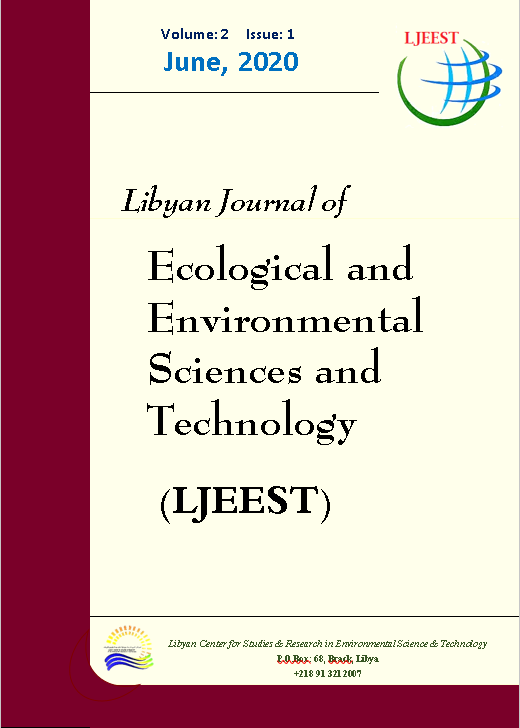Rhizosphere Bacteria Roles on Some Pesticides Stability and Degradation
DOI:
https://doi.org/10.63359/xf4zyr04Keywords:
Pesticide, Bacteria, Degradation, RhizosphereAbstract
This research was conducted with the aim of identifying the role and effect of localized root zone bacteria (R. meliloti, B. lupine, B. subtilus, Azotobacter sp.) In the soil (Rhizosphere) on some pesticide residues locally available in Wadi Al-Shati area, Libya, where residues of these pesticides accumulate in cultivated plants and often reach the following seasons. The pesticides degradation results showed that (R. meliloti) bacteria had no clear role in Chlorpyrifos and Linron breakdown while it worked to destroy significant concentrations of the pesticide after 12 hours with the microbes continuing to grow up to 24 hours, and the breakdown of the Glyphosate increased by the increasing of the dose Used. The results also showed that Linron has the ability to resist the biological decomposition of B. lupine, and the bacteria have no active role in Chlorpyrifos degradation, but it breaks down Glyphosate during 12 hours of exposure, and the microbe continued to grow until 24 hours, then the activation of the pesticide occurred and it became more resistant to biodegradation, and the bacteria had the ability to breakdown the pesticide. While (B. subtilus) bacteria has no role in degradation of Chlorpyrifos and Glyphosite, the microbe contributed to breaking Linron within 12 hours, then activation of the pesticide occurred over time, the longer the exposure period, the greater the resistance of the pesticide to decomposition and that the bacteria had no role in cracking Sencor during the first hours of exposure, but after 24 hours of exposure, the pesticide began to collapse. Azotobacter had no effect on Chlorpyrifos during the first hours of exposure, increased with the increased exposure period, the duration of the pesticide's survival, and the resistance to Linron decomposition increased with increasing concentrations used. The Glyphosate collapse did not occur within the first 12 hours of exposure, and then the destruction of the pesticide occurred after 12-24 hours, and then the pesticide returned to its activity within 72 hours. It is concluded that Azotobacter was more effective on the pesticides used, followed by the bacteria (B. lupini) and the bacteria (B. subtilus) and finally (R. meliloti).
References
ابوالذهب مصطفى ، الجعراني محمد (1983): " البكتيريا التمارين المعملية الأساسية. " الجزء الثاني ، دار المطبوعات الجديدة ، الإسكندرية - مصر.
زكـي سعد ، محمد عبد الوهاب ، محمد الصاوي (1988): " ميكروبيولوجيا الأراضي. " ، مكتبة الانجلو المصرية ، القاهرة - مصر.
زكـي سعد (1988): " ميكروبيولوجيا التطبيقية المعملية. " ، مكتبة الانجلو المصرية ، القاهرة - مصر.
محمـد عبد الوهاب ، محمد الصاوي (1996): " الميكروبيولوجيا التطبيقية. " الطبعة الأولى ، المكتبة الأكاديمية ، القاهرة - مصر.
المسلاتي ، حسين ابراهيم (2006): " تأثير بعض مبيدات الحشائش على الكائنات الدقيقة غير المستهدفة في التربة ، رسالة ماجستير ، معهد الدراسات والبحوث البيئية ، جامعة عين شمس ، القاهرة - مصر.
Alexander, M. (1977): "Introduction to soil microbiology." 2nd edition. John Wiley and Sons, Inc., New York, New York. 457 pp.
Chapman, R.A., Harris, C.R., (1982): "Persistence of isofenphos and isazophos in a mineral and an organic soil." J. Environ.Sci. Health., B17:355-361.
Gorder, G.W., Dahm, P.A., Tollefson, J.J., (1982): "Carbofuran persistence in cornfield soils." J. Econ. Entomol., 75:637-642,.
Gurcharan Singh, Kundra HC, Brar LS, Gupta RP and Singh G. (1994): "Effect of herbicides on soil microorganism dynamics, Rhizobium-legume symbiosis and grain yield of pea (Pisum sativum)." Annals of Agricultural Research 15: 22-26.
Metin DIÚRAK, FerdaÛ KAZANICI (2001): "Effect of Some Organophosphorus Insecticides on Soil Microorganisms." Turk J. Biol. 25 (2001) 51-58
Roger, P. A., Zimmerman, W. J., and Lumpkin, T. (1993): "Microbiological management of wetland rice fields. In ‘Soil Microbial Technologies." (Ed. B. Metting.) pp. 417-55. (Marcel Dekker: New York.)
Sandhu, PS. Dhingra, KK, Bhandari, SC, Gupta, RP. (1991): "Effect of hand-hoeing and application of herbicides on nodulation, nodule activity and grain yield of Lens culinaris." Med. Plant and Soil, 135, 293-296.
Sharmila, M., Ramanand, K., Sethunathan, N., (1989): "Effect of yeast extract on the degradation of organophosphorus insecticides by soil enrichment and bacterial cultures." Can. J. Microbiol., 35: 1105-1110,
Shin, J.Y. and M.A. Cheney, (1989): "Abiotic dealkylation and hydrolysis of atrazine by birnessite." Environ. Toxicol., Chem., 24(6): 1353-1360.
Wackett, L.P. (2004): "Evolution of enzymes for the metabolism of new chemical inputs into the environment." J. Biol. Chem., 279: 41259 41262.
Downloads
Published
Issue
Section
License

This work is licensed under a Creative Commons Attribution-NonCommercial 4.0 International License.














